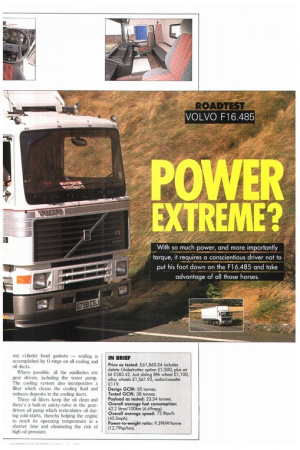• Has everyone gone power mad? Judging by the fire-breathing
Page 30

Page 31

If you've noticed an error in this article please click here to report it so we can fix it.
premium tractors currently being touted around Europe it's difficult not to come to the conclusion that they have. No sooner does one manufacturer claim to have "the most powerful tractor in Europe", then along comes another who raises the stakes even further. Where will it all end?
As many of the big truck engines currently churning out more than 336kW (450hp) have plenty of room for development, it's anybody's guess.
Volvo's flagship — the F16.485 — is a good case in point. Commercial Motor was the first magazine to break the news that the Swedish truck giant was developing a 16-litre engine back in October 1986. Sure enough exactly one year later the F16, complete with the 342kW (460hp) 16.12litre TD162F engine made its European debut. After a short spell behind the wheel in Sweden CM described the F16 as "bristling with innovation" and "giving an impression of immense power".
Not surprisingly, Volvo's rivals were not about to take things lying down. Soon after Scania launched its 350kW (470hp) 143.470. Then it was Daimler-Benz's turn with its 362kW (492hp) Powerliner 2 and finally Iveco came up with the 190.48 TurboStar.
In September 1989 Volvo bounced back with the uprated 357kW (479hp) F16, boldy advertised as "the most powerful tractor in Europe". To be accurate that boast was based on peak torque, rather than power — although the F16.485 led the field with 2,160Nm (1,5931bft) it was still beaten on outright power by the Mercedes 1748.
All that, however, is now irrelevant for during the intervening months both Renault and MAN have unveiled 373kW (500bp) tractive units and leapfrogged over the F16 on power. For the record, MAN's 19.502 also has the most torque in Europe with a mind-blowing (some would argue totally unnecessary) 2,350Nm (1,7431bft) of torque, although the F16 still delivers more newton metres than the Renault AE.
Power may hit the headlines, but it's torque that really counts.
It has not been easy getting hold of an F16 for test. In fact it's taken Volvo Trucks (Great Britain) three years to dig one up for us. Ironically, it appears in the same week that Volvo has launched a new interior for the F cab at the Paris Show so our model still has the old dash layout. Nevertheless its engine and driveline are certainly bang up-to-date. While other European truck builders have taken the vee-engine route to more power, Volvo has stuck rigidly with a straightsix. At the time of the original F16 launch, Volvo's chief engine designer Per Sune Berg revealed that while his company considered other configurations, such as a big vee, the inherent short stroke layout of the vee-engine sent Volvo back to the six.
Add to that the lower frictional losses, simpler servicing and a higher power-toweight ratio, and it's not difficult to see why Volvo kept on the straight (six) and narrow. The F16's air-to-air charge-cooled TD162FL engine is certainly far removed from those early Volvo turbocharged diesels of the sixties. Although it is a third bigger in capacity than the current 12-litre engine used in the F12 range, it is only 100trim longer, 50mm wider and some 50mm higher than the TD122F. It is also 190kg heavier than the F12 lump but the extra weight is balanced by its innovative design.
For instance, TD162FL's individual cylinder heads (like the Renault AE, the F16 engine has four-valves-per-cylinder) are bolted directly on to the block without any cylinder head gaskets — sealing is accomplished by 0-rings on all cooling and oil ducts.
Where possible, all the auxiliaries are gear driven, including the water pump. The cooling system also incorporates a filter which cleans the cooling fluid and reduces deposits in the cooling ducts.
Three oil filters keep the oil clean and there's a built-in safety-valve in the geardriven oil pump which reeirculates oil during cold-starts, thereby helping the engine to reach its operating temperature in a shorter time and eliminating the risk of high oil pressure.
























































































